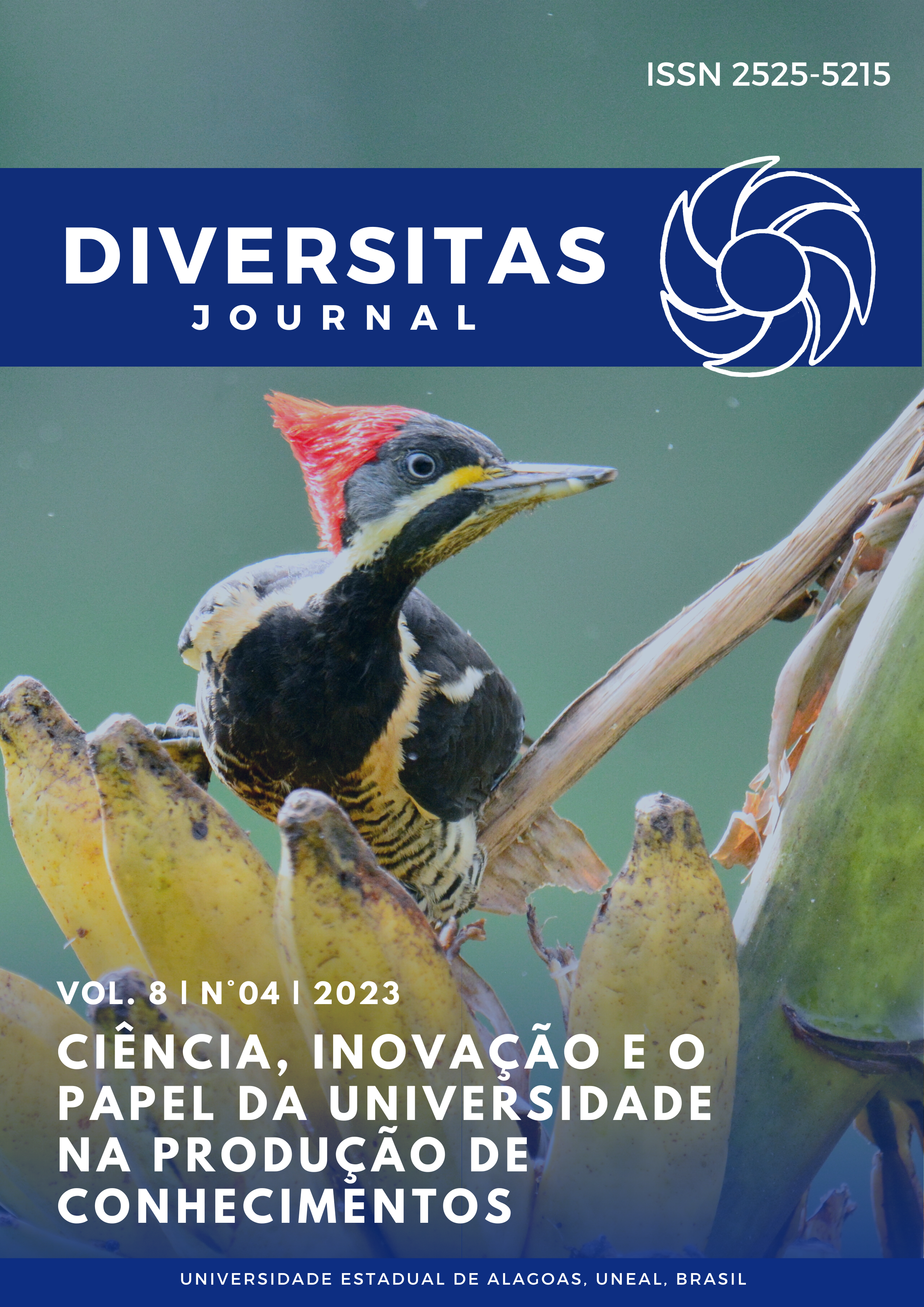Mathematical knowledge of first-year students in the light of Semiotic Representation Registers
DOI:
https://doi.org/10.48017/dj.v8i4.2782Keywords:
mathematical learning, theory of semiotic representation registers, mathematical concepts, elementary school 2Abstract
Many students face difficulties in completing high school satisfactorily due to lack of understanding of essential mathematical concepts. These difficulties can result in low grades, failure and even dropout. The Maceió campus, of the Federal Institute of Alagoas, receives more than 500 students per year, many of whom have difficulties in the subject of mathematics. To address this issue, we carried out a survey that uses the Theory of Semiotic Representation Registers to identify the deficiencies of first-year high school students on the Maceió campus. To achieve this objective, we first conducted a systematic literature review that investigated how the Theory of Semiotic Representation Registers has been used to analyze high school students' mathematical knowledge. After that, a five-question test was applied to 56 students from three of the seven courses. The analysis of the responses showed us that the students had great difficulty in converting the text in their mother tongue to algebraic language and in the question of numerical expression, which involved the conversion to only one record.
Metrics
References
Costa, J. G. da, Gomes, M. F. C. T., Oliveira, J. C. de, & Oliveira, V. A. S. de. (2017). Um olhar sobre as potencialidades de um curso de matemática básica para a diminuição das dificuldades na disciplina de matemática. Encontro Goiano de Educação Matemática, 6(6), Artigo 6.
Duval, R. (2009). Semiósis e pensamento humano: Registro semiótico e aprendizagens intelectuais. Editora Livraría da Física.
Duval, R., & Moretti, Trad. M. T. (2012). Abordagem cognitiva de problemas de geometria em termos de congruência. Revemat: revista eletrônica de educação matemática, 7(1), 118–138.
Duval, R., & Morettti, M. T. (2018). Como analisar a questão crucial da compreensão em Matemática? Revemat: Revista Eletrônica de Educação Matemática, 13(2), 1–27.
Hillesheim, S. F., & Thadeu Moretti, M. (2020). Congruência Semântica: Implicações didáticas no ensino da regra dos sinais. INTERMATHS: Revista de Matemática Aplicada e Interdisciplinar, 1(1), 101–118.
Holanda, M. D. M. de, Freitas, I. B., & Rodrigues, A. C. da S. (2020). Matemática no ensino médio: Dificuldades encontradas nos conteúdos das quatro operações básicas. Revista de Iniciação à Docência, 5(2), Artigo 2.
INEP. (2021). Press Kit SAEB. https://download.inep.gov.br/saeb/resultados/press_kit_saeb_2021.pdf
INEP. (2022). Censo Escolar 2021: Divulgação dos resultados. https://download.inep.gov.br/censo_escolar/resultados/2021/apresentacao_coletiva.pdf
Moretti, M. T., Brandt, C. F., & Almouloud, S. A. (2022). Congruência semântica: Um fenômeno semiótico e cognitivo a ser levado em conta na aprendizagem matemática. Quadrante, 92-112 Páginas.
Oliveira, A. S. dos S. de. (2015). Uma engenharia didática para o ensino das operações com números racionais por meio de calculadora para o quinto ano do ensino fundamental [Tese Doutorado em Educação, Pontifícia Universidade Católica de São Paulo.]
Oliveira, V. A., Paiva, E. L. de A., & Melo, L. M. (2017). Ensino de matemática: uma análise das dificuldades apresentadas pelos alunos ingressantes no ensino médio integrado do IFTM. Anais do Seminário de Pesquisa e Inovação Tecnológica - SEPIT.
Paraol, C. M., & Rodriguês, J. S. (2018). Os registros de representação semiótica de frações em atividades envolvendo tratamento e conversão. REMAT, 4(2), 21–37.
Ramos, M. L. P. D., & Curi, E. (2014). Dificuldades e erros de alunos do 1o ano da educação profissional tecnológica de nível médio em matemática: Reflexões e desafios. Revista de Produção Discente em Educação Matemática, 3(1).
Rezende, O. L. T. de, Lorenzoni, L. L., & Souza, M. A. V. F. de. (2018). Um estudo das representações semióticas de função via uma atividade de modelagem matemática. Revista Brasileira de Ensino de Ciência e Tecnologia, 11(3).
Santana, L., Gualandi, J., & Soares, M. (2019). Registros de representação semiótica: Experiência no ensino de funções quadráticas com alunos do Ensino Médio Integrado. Educação Matemática Debate, 3(7), 8–30.
Silva, F. A. F. (2018). Graus de não congruência semântica nas conversões entre os registros geométrico bidimensional e simbólico fracionário dos números racionais [Tese Doutorado em Ensino de Ciências, Universidade Federal Rural de Pernambuco].
Siqueira, J. E. M., & Bellemain, F. (2011). Articulando as Representações Algébricas e a Geométrica das Equações Quadráticas a partir da Noção de Registros de Representações Semióticas de Duval. Em Teia | Revista de Educação Matemática e Tecnológica Iberoamericana, 2(3), Artigo 3.
Stormowski, V., Gravina, M. A., & Lima, J. V. de. (2013). Tecnologia na aula de matemática: A importância do potencial semiótico. Revista Novas Tecnologias na Educação, 11(3), Artigo 3.
Wohlin, C., Runeson, P., Höst, M., Ohlsson, M. C., Regnell, B., & Wesslén, A. (2012). Systematic Literature Reviews. Em C. Wohlin, P. Runeson, M. Höst, M. C. Ohlsson, B. Regnell, & A. Wesslén (Orgs.), Experimentation in Software Engineering (p. 45–54). Springer.
Downloads
Published
How to Cite
Issue
Section
License
Copyright (c) 2023 Diogo Meurer de Souza Castro, Davi Celestino dos Sant Barbosa, Enaldo Vieira de Melo

This work is licensed under a Creative Commons Attribution 4.0 International License.
The Diversitas Journal expresses that the articles are the sole responsibility of the Authors, who are familiar with Brazilian and international legislation.
Articles are peer-reviewed and care should be taken to warn of the possible incidence of plagiarism. However, plagiarism is an indisputable action by the authors.
The violation of copyright is a crime, provided for in article 184 of the Brazilian Penal Code: “Art. 184 Violating copyright and related rights: Penalty - detention, from 3 (three) months to 1 (one) year, or fine. § 1 If the violation consists of total or partial reproduction, for the purpose of direct or indirect profit, by any means or process, of intellectual work, interpretation, performance or phonogram, without the express authorization of the author, the performer, the producer , as the case may be, or whoever represents them: Penalty - imprisonment, from 2 (two) to 4 (four) years, and a fine. ”


















